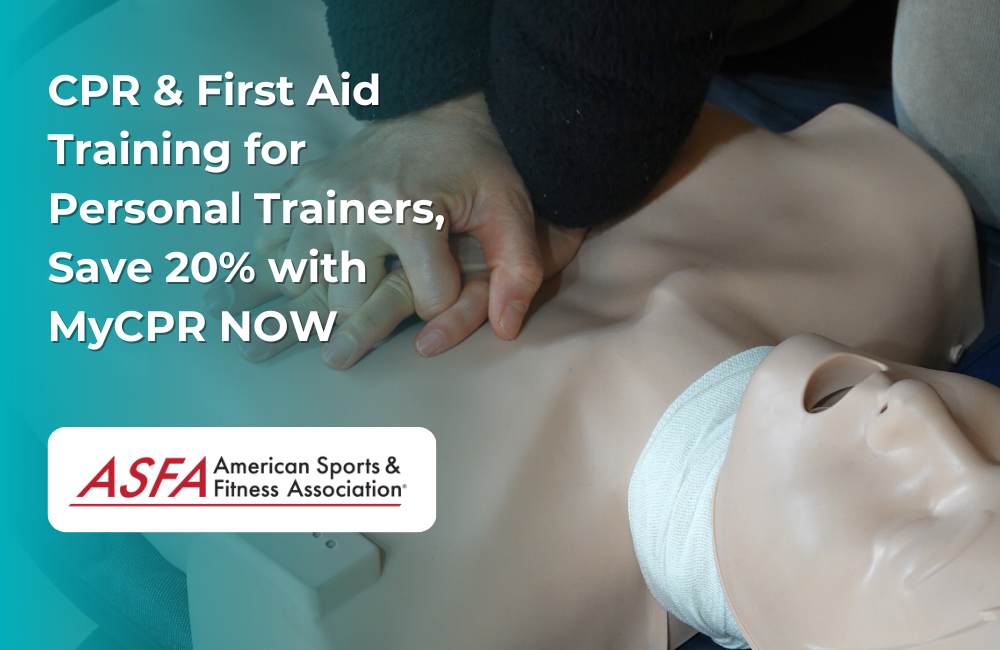Why CPR and First Aid Training is Essential for Personal Trainers
A career as a personal trainer involves far more than just guiding clients through workouts and developing fitness plans. Personal trainers must also be equipped to handle emergency situations, which can arise without warning in any fitness environment. Compared to many other professions, personal trainers have a higher likelihood of needing to administer CPR or First Aid due to the physical nature of their work and the potential risks associated with exercise. Whether it’s responding to a client who has overexerted themselves or addressing injuries from gym equipment, being trained in CPR and First Aid is not just an added skill—it’s a vital competency that can save lives.
First aid serves as a critical preliminary measure before the arrival of emergency services, helping to stabilize the injured person and prevent further injury.
Personal trainers often work with clients who push themselves to achieve new fitness milestones. While this determination can lead to significant progress, it can also increase the risk of injuries or sudden health events, such as heart attacks or fainting spells. In these high-stakes moments, having the knowledge and confidence to perform CPR and administer First Aid can make all the difference. It not only helps ensure client safety but also builds trust, showing clients that their trainer is prepared for any situation and genuinely cares about their well-being.
Understanding the Scope of CPR, AED, and First Aid Certifications
CPR, AED, and First Aid certifications provide comprehensive training that covers a range of critical emergency response skills. These certifications typically include:
-
Basic First Aid Skills: These involve understanding how to treat minor injuries such as cuts, sprains, and burns. More importantly, it covers how to recognize more serious conditions, such as strokes or diabetic emergencies, and how to provide initial care until professional medical help arrives.
-
CPR Techniques: Learning CPR involves mastering the steps to help maintain vital blood flow to the brain and heart during cardiac arrest. Proper technique is crucial, as it involves a combination of chest compressions and rescue breaths. Performing CPR correctly can double or even triple a person’s chance of survival after a cardiac arrest.
-
Using an AED: An AED is a portable device that checks the heart’s rhythm and can send an electric shock to the heart to try to restore a normal rhythm. This device is critical in the event of sudden cardiac arrest (SCA), where the heart unexpectedly stops beating. Knowing how to use an AED effectively involves understanding the device’s prompts and correctly positioning the pads on the patient’s chest. Proper AED use, combined with CPR, significantly increases the chances of survival and recovery.
Having well-organized first aid kits at home, in the car, and at the workplace is essential for providing immediate care during emergencies.
The goal of this training is to ensure that fitness professionals are prepared to respond to a variety of medical emergencies with confidence and competence. Many gyms and fitness facilities mandate that all trainers hold current CPR and First Aid certifications to meet safety standards and provide the highest level of care for their members.
Understanding First Aid Principles
First aid is a vital skill that can help save lives in emergency situations. It involves providing immediate care to an injured person or someone who is ill, with the goal of preserving life, preventing further injury, and promoting recovery until medical services arrive. The core principles of first aid are based on the ABCs: airway, breathing, and circulation. This process must be carried out in that order to ensure the best possible outcome for the patient.
First aid techniques are designed to be simple yet effective, allowing individuals with no previous medical experience to perform them with minimal equipment. While first aid is not a substitute for medical treatment from a trained medical professional, it can make a significant difference in the injured person’s outcome. By stabilizing the patient and preventing further injury, first aid can buy crucial time until emergency medical services arrive.
Recognizing and Responding to Emergencies in a Fitness Setting
Medical emergencies in a fitness environment can happen quickly and unexpectedly. For example, consider a situation where a gym member appears to be taking a rest between sets but suddenly collapses. As a personal trainer, being able to swiftly assess the situation is crucial. Training teaches you to quickly check for responsiveness and breathing. If the individual is unresponsive and not breathing normally, immediate action is required.
Ensuring that aid kits are easily accessible in fitness facilities can significantly improve the response time and effectiveness of first aid during emergencies.
The first step is to call 911 or instruct someone nearby to do so. Meanwhile, you should begin CPR immediately, starting with chest compressions to maintain blood circulation to the vital organs. If an AED is available, it should be retrieved and used as soon as possible. Your training will guide you through each step: turning on the AED, attaching the pads correctly, and following the device’s prompts. When the AED advises a shock, ensure that no one is touching the person to prevent injury to bystanders. After delivering the shock, continue CPR until emergency medical services arrive.
The average response time for emergency medical services is between five to 10 minutes, but in cardiac emergencies, brain damage can begin within four minutes without oxygen. This short window makes every second count, underscoring the critical nature of prompt and effective action.
Common Injuries and Emergencies
Accidents and illnesses can happen to anyone at any time, making it essential for personal trainers to be prepared for a variety of situations. Some common injuries and emergencies that may require first aid include:
-
Anaphylaxis: A severe allergic reaction that can occur after an insect sting or eating certain foods, requiring immediate emergency treatment.
-
Heavy Bleeding: A serious condition that necessitates prompt action to control blood loss and prevent shock.
-
Burns and Scalds: Injuries caused by heat, flames, or hot liquids that need immediate cooling and care.
-
Chemical Burns: Resulting from exposure to harmful chemicals, these require thorough rinsing and medical attention.
-
Choking: When food or other objects block the airway, quick intervention is critical to restore breathing.
-
Drowning: A life-threatening condition that demands immediate resuscitation efforts.
-
Electric Shock: Injuries from electrical faults that can cause burns or cardiac issues, needing urgent care.
-
Fractures: Broken bones from falls or impacts that require immobilization and professional medical evaluation.
-
Heart Attack: A life-threatening condition where recognizing symptoms and providing early CPR can save lives.
-
Needlestick Injuries: Punctures from needles that pose infection risks and need careful handling.
-
Poisoning: Potentially life-threatening, often from medications, household chemicals, or plants, requiring immediate action.
-
Shock: A critical condition where the circulatory system fails, needing rapid intervention to maintain blood flow.
-
Stroke: A medical emergency where quick recognition and response are vital to minimize brain damage.
Recognizing these life-threatening conditions and knowing how to respond can make all the difference in an emergency.
The Role of AEDs in Cardiac Arrest Emergency Response
AEDs are essential tools in the fight against sudden cardiac arrest (SCA). Many fitness facilities are equipped with AEDs, and it is imperative for personal trainers to know the exact location of these devices and how to use them. An AED works by analyzing the heart's rhythm and advising the operator to deliver a shock only if it is necessary. This shock can reset the heart's rhythm and is often a key factor in survival for someone experiencing SCA.
During CPR training, personal trainers learn how to integrate AED use seamlessly with chest compressions and rescue breaths. The training emphasizes not just the technical use of the AED but also the importance of clear communication with other bystanders and maintaining a calm, focused demeanor during an emergency. Trainers learn how to direct bystanders, secure the area, and ensure that the person receives uninterrupted care until professional help arrives.
First Aid Kit Essentials
A well-stocked first aid kit is an essential item for every home, car, and workplace. It ensures that you are prepared to handle minor injuries and provide initial care in more serious situations. Key items to include in your first aid kit are:
-
Bandages and Band-Aids: For covering cuts and wounds.
-
Antiseptic Wipes and Spray: To clean wounds and prevent infection.
-
Gauze and Medical Tape: For dressing larger wounds and securing bandages.
-
CPR Mask and Gloves: To protect both the rescuer and the injured person during resuscitation efforts.
-
Other First Aid Supplies: Such as scissors, tweezers, and a digital thermometer.
Regularly check the expiration dates of any medications and supplies in your aid kit and replace them as needed to ensure everything is in good working order when an emergency arises.
Building a Safer, More Prepared Fitness Environment with a First Aid Kit
The best fitness certifications are those that encompass a holistic approach to health and wellness, incorporating CPR and First Aid training as essential components. As a personal trainer, your role is to promote overall wellness, which includes being prepared to handle medical emergencies effectively. By obtaining CPR and First Aid certifications, you not only enhance your professional credentials but also show your clients that you are committed to their safety and well-being.
Having well-stocked first aid kits in fitness centers ensures that trainers are prepared to handle minor injuries and provide initial care in more serious situations.
Moreover, a well-trained fitness staff can significantly enhance the overall safety and atmosphere of a gym or fitness center. Clients feel more at ease knowing that their trainers are prepared for emergencies, which can enhance client retention and satisfaction. Additionally, being prepared for emergencies can also reduce the gym’s liability and enhance its reputation as a safe and responsible facility.
Maintaining First Aid Skills
First aid skills are perishable and require regular practice and training to maintain proficiency. It’s recommended to take a first aid course every two years to stay up-to-date with the latest techniques and guidelines. Additionally, regular refresher courses or re-certification can help maintain skill and confidence in providing first aid.
It’s also important to note that first aid techniques and guidelines can change over time, so staying informed and up-to-date with the latest information is crucial. The British Medical Journal and other reputable sources provide valuable information and resources for maintaining first aid skills. By keeping your knowledge current, you ensure that you are always prepared to provide the best possible care in an emergency.
By integrating these new sections, the article will provide a comprehensive overview of the importance of CPR and First Aid training for personal trainers, covering essential principles, common emergencies, necessary equipment, and the importance of ongoing education.
Expanding Career Opportunities with CPR and First Aid Certification
In addition to improving client trust and safety, CPR and First Aid certifications can open up new career opportunities for personal trainers. Many employers in the fitness industry, from boutique studios to large health clubs, prioritize hiring trainers with comprehensive emergency response skills. Some roles, such as those involving high-intensity training or senior fitness programs, may specifically require advanced First Aid knowledge due to the higher risks involved.
For those looking to expand their career into wellness coaching or corporate fitness, having CPR and First Aid certification is often a prerequisite. Employers in these fields recognize the value of trainers who can provide not just fitness guidance but also immediate care in the event of a health emergency. Being certified can therefore make you more competitive in the job market and potentially increase your earning potential.
Conclusion
Incorporating CPR and First Aid skills into your personal training repertoire is not just an optional enhancement—it's a critical responsibility. Emergencies can strike at any moment, and being equipped with the right skills can mean the difference between life and death. As a personal trainer, your commitment to your clients' well-being goes beyond helping them reach their fitness goals; it includes ensuring their safety during every session.
By getting certified in CPR and First Aid, you are taking a proactive step to protect your clients, enhance your professional skills, and contribute to a safer, more prepared fitness environment. Don't wait for an emergency to remind you of the importance of these life-saving skills. Empower yourself to be a better trainer and a life-saver.





